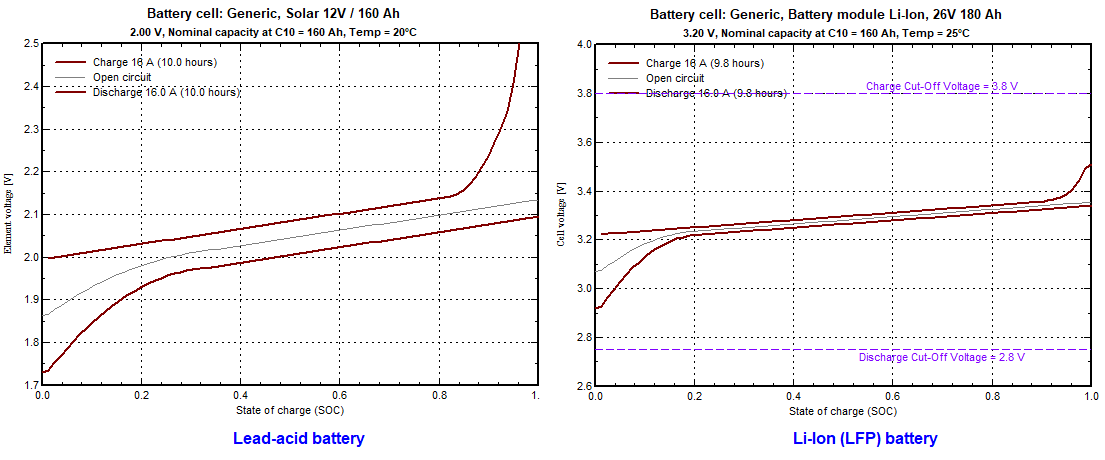Battery voltage model
The voltage model is quite similar for Lead-acid and Li-Ion technologies.
The base voltage is the open-circuit voltage VocBattery, described separately.
In the linear region, the Voc voltage is mainly modified by the Internal resistance. The main difference between technologies is the overcharging behavior: Gassing phenomenon in Lead-acid, and internal resistance increase in Li-Ion.
The basic model takes the simple form :
\(Vbattery = Voc_{battery} + ResInt * Ibattery\)
For lead-acid, above the overcharging threshold, we have to add the gassing voltage correction:
\(Vbattery = Voc_{battery} + ResInt * Ibattery + VGassing\)
where:
- Voc_battery is a function of SOC, with a temperature correction for Lead-acid
- ResInt is constant for Lead-acid. For Li-Ion, there is a temperature correction, as well as an exponential correction in overcharging and deep discharge regions,
- VGassing is only applicable to lead-acid batteries.
- Remember that the IBattery is positive when charging, and negative when discharging.
The graphs show a comparison between lead-acid and Li-Ion voltage models, for a discharge rate of 10 hours (C10). We may observe that the ohmic loss is far lower with Li-Ion, as the internal resistance is much better. We can see the gassing curve for the Lead-acid, and the effect of the ResInt increase at high SOC on the Li-Ion. Other characteristics are very similar.
State of charge determination
This model is often used for the determination of the SOC, as a function of the voltage (for charging/discharging control). For a given voltage, we see that the determination of the SOC is highly dependent on the current, especially for Lead-acid. On the other hand, the variation of the Lead-acid (13.5% for SOC = 0...1) is higher than the variation of the Li.Ion LFP (4.8%). Remember also that the lead-acid voltage depends on the temperature; this is a high source of uncertainty when measuring a battery on the field.
The detection of the overcharging and deep discharge conditions is facilitated by the current deviation enhancements at these extremities. The reconnexion has to be done on the VocBattery voltage curve, not sensitive to the current as the charge or load is disconnected. Therefore in the controllers, a large voltage hysteresis has to be defined for avoiding oscillations.
Polarization
With lead-acid batteries in open circuit, the measured voltage is often not well defined: we can observe a voltage drift depending on immediately preceding operating conditions. However this has a characteristic time less than one hour, and only affect the states of very low current. PVsyst doesn't take this effect into account.
